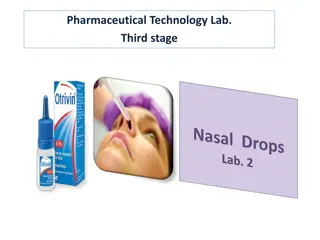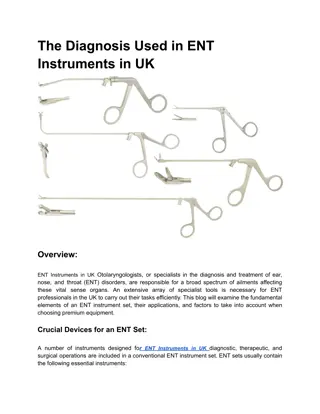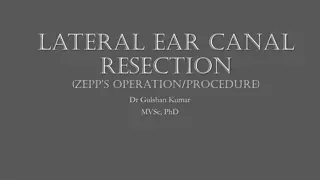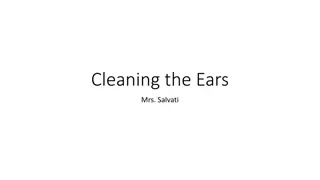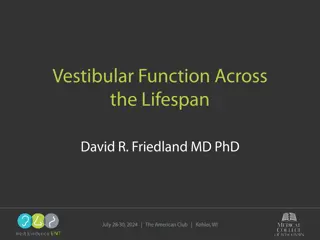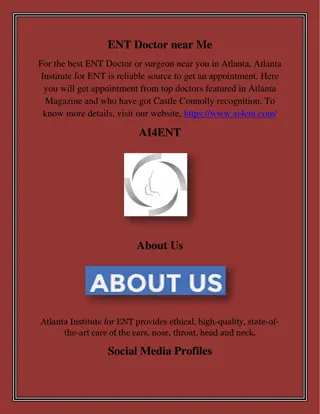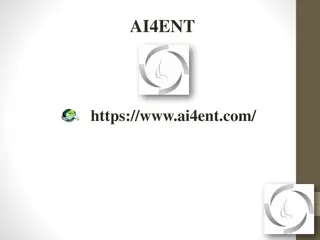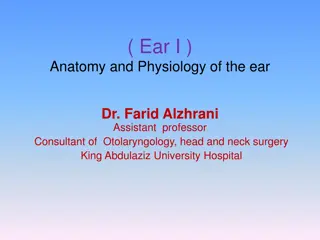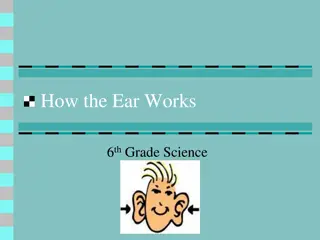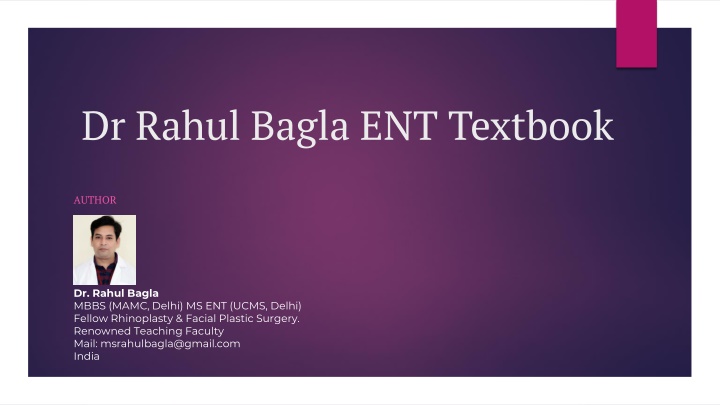
The Functions and Anatomy of the Ear by Dr. Rahul Bagla
Discover the fascinating world of the ear as explained by renowned author Dr. Rahul Bagla. Learn about the vital functions of hearing and balance, explore the anatomy of the ear's external, middle, and internal regions, and delve into the detailed structure of the auricle. Gain insights into the components of the external ear and the muscles that contribute to its functionality.
Download Presentation

Please find below an Image/Link to download the presentation.
The content on the website is provided AS IS for your information and personal use only. It may not be sold, licensed, or shared on other websites without obtaining consent from the author. If you encounter any issues during the download, it is possible that the publisher has removed the file from their server.
You are allowed to download the files provided on this website for personal or commercial use, subject to the condition that they are used lawfully. All files are the property of their respective owners.
The content on the website is provided AS IS for your information and personal use only. It may not be sold, licensed, or shared on other websites without obtaining consent from the author.
E N D
Presentation Transcript
Dr Rahul Bagla ENT Textbook AUTHOR Dr. Rahul Bagla MBBS (MAMC, Delhi) MS ENT (UCMS, Delhi) Fellow Rhinoplasty & Facial Plastic Surgery. Renowned Teaching Faculty Mail: msrahulbagla@gmail.com India
Anatomy of Ear AUTHOR DR RAHUL BAGLA
Introduction to the Functions of the Ear The human ear is responsible for two primary functions: hearing and balance. Hearing: The ear collects sound waves, amplifies them, and converts them into electrical signals that the brain can interpret. This process helps in perceiving and understanding environmental sounds. Balance (Equilibrium): The vestibular system within the inner ear detects changes in head position and movement, helping us maintain balance and avoid falls. Additional Roles: The ear also serves as a warning system, alerting us to potentially dangerous sounds, and aids in communication, enabling us to hear and interpret speech, music, and other sounds.
Anatomy of the Ear The ear is anatomically divided into three regions: External Ear 1. Middle Ear 2. Internal Ear 3. Each part plays a distinct role in hearing and balance, with specialized structures for converting sound waves into electrical signals and maintainigg equilibrium.
Components of the External Ear The external ear is composed of three main parts: Auricle (Pinna): This visible part of the ear captures sound waves and directs them into the external auditory canal. 1. External Auditory Canal: This canal extends from the auricle to the tympanic membrane (eardrum), funnelling sound waves towards the eardrum. 2. Tympanic Membrane (Eardrum): Separates the external ear from the middle ear and vibrates in response to sound waves. 3.
Detailed Structure of the Auricle (Pinna) The auricle is made of yellow elastic cartilage covered by skin, except for the lobule, which contains adipose tissue. Prominences and Depressions: The outside rim is called helix and it ends inferiorly at the lobule. o A smaller curved rim, parallel and anterior to the helix, is the antihelix. o The large hollow centre area is called concha. o The external acoustic meatus starts from bottom of the concha. o Just anterior to the opening of the external acoustic meatus and in front of the concha, is an elevation (the tragus). o Opposite the tragus, is another elevation called antitragus. o
Muscles of the Pinna Extrinsic Muscles (three in number): These include the anterior, superior, and posterior auricular muscles. They pass from the scalp or skull to the auricle and play a role in positioning of the auricle. Intrinsic Muscles (six in number): These muscles pass between the cartilaginous parts of the auricle and can change the shape of the auricle. However, they are small, inconsistent, and generally have no useful function.
Blood Supply of the Pinna Posterior Auricular Artery: A branch of the external carotid artery, it is the main artery supplying the medial surface (except the lobule), concha, middle and lower portions of the helix, and the lower part of the antihelix. Anterior Auricular Artery: A branch of the superficial temporal artery, it supplies the upper portions of the helix, antihelix, triangular fossa, tragus, and lobule. Small Auricular Branch from the Occipital Artery: This may assist the posterior auricular artery.
Lymphatic, and Nerve Supply of the Pinna Lymphatic Drainage: The medial surface drains to mastoid nodes, while the tragus and upper lateral surface drain to the preauricular nodes. Nerve Supply: Auriculotemporal Nerve (V3): Supplies the anterosuperior part. o Greater Auricular Nerve (C2, C3): Supplies most of the outer medial surface. o Facial Nerve (VII) and Vagus Nerve (X) also play significant roles in sensation. o
External Auditory Canal (EAC) The external auditory canal (EAC) extends from the bottom of the concha to the tympanic membrane. The External Auditory Canal (EAC) connects the concha to the tympanic membrane and measures about 24 mm along its posterior wall, with the anterior wall being 6 mm longer. It has an S-shape, with the cartilaginous part directed upwards, backwards, and medially, and the bony part directed downwards, forwards, and medially. The EAC has two main sections: a cartilaginous outer one-third and a bony inner two-thirds.
Cartilaginous Part of the External Auditory Canal The outer one-third (8mm) of the EAC is made of yellow elastic cartilage. It is covered by thick skin that contains hairs and modified apocrine sweat glands (ceruminous glands) that produce earwax. Therefore furuncles (staphylococcal infection of hair follicles) are seen only in this part. This section also has two horizontal deficiencies the fissures of Santorini, which increase flexibility but also allow infections and neoplasms to spread to and from the parotid and temporomandibular regions.
Bony Part of the External Auditory Canal The inner two-thirds (16 mm) of the EAC is narrower and primarily made of the tympanic part of the temporal bone. The isthmus, about 5-6 mm lateral to the tympanic membrane, narrows the canal, making foreign body removal difficult. Beyond the isthmus, lies a wedge-shaped anterior recess which acts as a gutter for ear discharge and debris and becomes a tough spot to access either in the clinic or at surgery. The foramen of Huschke is sometimes also found in the anteroinferior part, can persist into adulthood and allows infections and neoplasms to spread. Wax if present over pars flaccida or attic region is rarely true wax and almost always associated with an underlying cholesteatoma. Sagging in the posterosuperior part indicates acute mastoiditis.
Relationships and Nerve Supply of the EAC The EAC has various anatomical relationships: Superior: Middle cranial fossa Inferior: Parotid gland Posterior: Mastoid antrum and air cells and the facial nerve Anterior: Temporomandibular joint (TMJ) Medial: Tympanic membrane and middle ear Lateral: Outside world The EAC's nerve supply includes the auriculotemporal nerve (CN V3) for the anterior and superior walls, the auricular branch of CN X for the posterior and inferior walls, and CN VII (facial nerve) for the mastoid and posterior EAC skin.
Clinical Relevance of the External Ear Hitzelberger s Sign: A sign of hypoesthesia in the posterior meatal wall due to pressure on the facial nerve, often in cases of acoustic neuroma. Vasovagal Reflex: Can occur during cleaning of the ear canal, leading to symptoms like coughing, bradycardia, or syncope. Ramsay Hunt Syndrome: Involves vesicles on the ear and facial nerve dysfunction due to herpes zoster. These clinical points highlight the importance of the ear's structure in health and diagnosis.
Tympanic Membrane (Eardrum) The tympanic membrane forms a partition between the external acoustic canal and the middle ear. It is located at the medial end of the external auditory meatus and forms the majority of the lateral wall of the middle ear cavity. The tympanic membrane is set obliquely, which means the posterosuperior part of the tympanic membrane is more lateral than the anteroinferior part. The tympanic membrane measures 9 10 mm in height, 8 9 mm in width, and is about 0.1 mm thick. The tympanic membrane is slightly oval in shape and forms an angle of approximately 55 with the floor of the external auditory canal.
Parts of Tympanic Membrane (Eardrum) Pars Tensa: It forms the lower and majority part of the TM. The periphery of the TM is thickened to form the annulus tympanicus, which fits into the bony tympanic sulcus. From the superior limits of the sulcus, the annulus becomes a fibrous band that runs centrally as the anterior and posterior malleolar folds toward the lateral process of the malleus. The central part is tented inwards at the level of the malleus, called the umbo, and a bright cone of light can be observed radiating in the anteroinferior quadrant of the TM. Pars Flaccida: It forms the upper small part of the TM and often appears slightly pinkish. It is situated above the lateral process of the malleus, between the notch of Rivinus and the anterior and posterior malleolar folds.
Layers of the Tympanic Membrane The tympanic membrane consists of three layers: Outer epithelial layer: It is continuous with the skin of the EAC. 1. Middle fibrous layer: It is composed of radial and circular fibres that allow the membrane to vibrate efficiently. 2. Inner mucosal layer: It is continuous with the mucosa of the middle ear. 3. These layers work together to transmit sound vibrations to the ossicles.
Blood and Nerve Supply to the Tympanic Membrane Blood Supply: The lateral surface is supplied by the auricular branch of the maxillary artery. o The medial surface is supplied by the anterior tympanic branches and stylomastoid artery. o Nerve Supply: The lateral surface receives innervation from the auriculotemporal nerve (V3) and auricular branch of CN X. o The medial surface is innervated by the tympanic branch of the glossopharyngeal nerve (CN IX). o
Anatomy of the Middle Ear The middle ear is an irregular, air-filled space located in the temporal bone. It is lined with mucous membrane and situated between the tympanic membrane (eardrum) laterally and the inner ear medially. The primary role of the middle ear is to transmit sound vibrations from the tympanic membrane to the inner ear. Key components of the middle ear include the ear ossicles (malleus, incus, stapes), the muscles (tensor tympani, stapedius), and nerves (chorda tympani, tympanic plexus). The middle ear is connected to the mastoid antrum and nasopharynx.
Divisions of the Middle Ear Epitympanum (Attic): Located above the level of the pars tensa, medial to the pars flaccida. It is separated from the mesotympanum and hypotympanum by mucosal folds. Mesotympanum: The main cavity, opposite the pars tensa. Hypotympanum: Located below the pars tensa and tympanic sulcus, it contains areas like the retrotympanum (posterior) and protympanum (anterior). These divisions help organize the space for various structures and functions.
Boundaries of the Middle Ear Roof (Tegmental Wall): Made of thin bone (tegmen tympani), separating the middle ear from the middle cranial fossa. Includes a bony crest called the "cog," which divides the epitympanum. Floor (Jugular Wall): Thin bone separating the hypotympanum from the jugular bulb. Jacobson's nerve enters through this area. Anterior Wall (Carotid Wall): Separates the middle ear from the internal carotid artery, with openings for the eustachian tube and the tensor tympani muscle. Posterior Wall (Mastoid Wall): Partially incomplete, it houses the pyramid (stapedius muscle) and communicates with the mastoid air cells. Lateral Wall (Membranous Wall): Formed by the tympanic membrane, scutum (bony portion), and walls of the epitympanum. Medial Wall (Labyrinthine Wall): Separates the middle ear from the internal ear, with important structures like the oval window, round window, and facial nerve canal.
Mastoid Antrum and Its Boundaries Mastoid Antrum: An air-filled space, measuring approximately 9mm in height, 14mm in width, and 7mm in depth. It communicates with the middle ear through the aditus, and it is lined with mucous membrane, sharing continuity with the middle ear.
Mastoid Antrum and Its Boundaries Boundaries: Roof: Tegmen antri, a continuation of the tegmen tympani. o Lateral Wall: Thick plate of temporal bone, externally marked by Macewen s triangle. o Medial Wall: Related to the petrous bone and posterior semicircular canal. o Anterior Wall: Leads into the attic. o Posterior Wall: Communicates with mastoid air cells. o Floor: Forms the connection to mastoid air cells. o
Mastoid Air Cells The mastoid contains a honeycomb-like system of air cells beneath the bony cortex, classified as: Well-pneumatized: Well-developed air cells with thin septa. o Diploetic: Contains marrow spaces and a few air cells. o Sclerotic: Lacks air cells and marrow spaces. o Types of Mastoid Air Cells: Zygomatic cells, retrofacial cells, perilabyrinthine cells, etc. o Air cells serve to reduce skull weight and are involved in the resonance of sound.
Korners Septum Squamous and petrous parts of temporal bone together forms the mastoid. In few instances petrosquamosal suture remains as a bony plate known as Korner s septum, which separates superficial squamosal cells from the deep petrosal cells. Korner s septum causes difficulty in locating the antrum and the deeper cells. Removal of Korner s septum is must in order to reach mastoid antrum during surgery. Otherwise it will lead to incomplete removal of disease at mastoidectomy.
Ear Ossicles Malleus (Hammer): The largest ossicle, connected to the tympanic membrane. Components include the head, neck, anterior and lateral processes, and handle. o The head articulates with the incus. o Incus (Anvil): Connects the malleus to the stapes. It has a body, short process, and long process that connects to the stapes. o Stapes (Stirrup): The smallest ossicle, transmitting sound vibrations to the oval window. It consists of the head, neck, crura (anterior and posterior), and footplate. These ossicles form a chain transmitting vibrations from the eardrum to the inner ear.
Muscles of the Middle Ear Stapedius Muscle: Arises from the pyramid on the posterior wall of the middle ear. Contracts to dampen loud sounds by pulling the stapes posteriorly. o Innervated by the nerve to stapedius, a branch of CN VII. o Tensor Tympani Muscle: Arises from the bony canal near the eustachian tube. Contracts to tense the tympanic membrane, reducing vibrations. o Innervated by the mandibular nerve (V3). o
Tympanic Plexus & Chorda Tympani Tympanic Plexus: Formed by the tympanic branch of the glossopharyngeal nerve and sympathetic fibres from the carotid plexus. Provides innervation to the mucous membranes of the middle ear, mastoid air cells, and the eustachian tube. The lesser petrosal nerve, a branch of the tympanic plexus, carries parasympathetic fibres to the otic ganglion, influencing the parotid gland. Chorda Tympani: A branch of the facial nerve, that enters the middle ear via the posterior canaliculus. Carries taste sensations from the anterior two-thirds of the tongue. Also provides secretomotor fibres to the submaxillary and sublingual salivary glands.
Middle Ear Mucosa and Histology The middle ear is lined by respiratory-type mucous membrane, which produces mucus to keep the area moist. The mucosa covers all structures, including ossicles, muscles, and nerves, and is continuous with that of the nasopharynx. Histology: The mucosa varies in type, from ciliated epithelium in the eustachian tube to cuboidal in the posterior parts of the tympanic cavity.
Blood Supply and Lymphatic Drainage of Middle ear Blood Supply: Main arteries include the anterior tympanic branch of the maxillary artery and stylomastoid branch of the posterior auricular artery. o Other minor vessels supply different parts of the middle ear and mastoid region. o Lymphatic Drainage: The middle ear lymph drains into retropharyngeal and parotid lymph nodes. o The internal ear has no lymphatic drainage. o
Anatomy of the Internal Ear The internal ear, also known as the labyrinth, is responsible for both hearing and balance. It is a highly protected structure, enclosed within the petrous part of the temporal bone. It is located between the middle ear and the brain, deeply positioned within the skull. The internal ear includes: Cochlea: Responsible for hearing. o Vestibular system (Utricle & Semicircular canals): Responsible for balance. o
Functions of the Inner Ear Hearing: The internal ear is responsible for the transduction of mechanical energy into electrical signals that can then be passed to the brain along the auditory or vestibular nerves. 1. Movements of the stapes footplate transmitted to cochlear fluids move the basilar membrane and set up a shearing force between the tectorial membrane and the hair cells. The distortion of hair cells gives rise to cochlear microphonics, which triggers the nerve impulse. Nerve impulses are sent to the brain for processing. Balance: The internal ear detects position and motion, helping to maintain equilibrium. 2.
Connections of the Internal Ear The internal ear connects to the middle ear via two openings: 1. Oval window where sound vibrations from the stapes enter the cochlea. 2. Round window - this allows pressure release from the cochlear fluid movements. Two main pathways connect the internal ear to the brain: 1. Internal acoustic meatus: Transmits the cochlear nerve (for hearing) and the vestibular nerve (for balance). 2. Cochlear aqueduct: A small canal involved in fluid regulation.
Parts of the Inner Ear Bony Labyrinth: It is a bony, rigid, protective shell filled with perilymph. The bony labyrinth has three distinct parts: 1. Vestibule (Central chamber). Semicircular Canals (posterior part): It detects rotational movements. Cochlea (anterior part): It is involved in hearing. Membranous Labyrinth: The membranous labyrinth is suspended/ floats inside the bony labyrinth and contains endolymph. It has three distinct parts: 2. Membranous Vestibular Labyrinth (Inside vestibule): Part of the vestibular system for balance. Membranous Semicircular Canals (Inside Semicircular ducts). Detect rotational movements. Membranous Cochlea (Inside Cochlear duct) : Houses sensory receptors for hearing.
Vestibule of the Bony Labyrinth The vestibule is a 5 mm oval chamber in the bony labyrinth, positioned between the middle ear and internal acoustic meatus, connecting anteriorly to the cochlea and posterosuperiorly with the five openings of semi-circular canals. 1. The vestibule also communicates with the posterior cranial fossa through the vestibular aqueduct. The endolymphatic duct passes through the vestibular aqueduct. 2. Walls of vestibule 3. Lateral wall: Features the oval window (fenestra vestibuli), closed by the stapes footplate. Medial wall: Contains two recesses spherical (for saccule) and elliptical (for utricle) with nerve passage apertures (macula cribrosa).
Semicircular canals of the Bony Labyrinth 1. Three Canals & Their Orientation Superior (Anterior): 15 20 mm; detects sagittal plane rotation (head nodding) Lateral (Horizontal): 12 15 mm; detects transverse plane rotation (head shaking); angled ~30 to horizontal Posterior (Vertical): 18 22 mm; detects coronal plane rotation (head tilting) All three are orthogonal (90 to each other), forming a "solid angle." 2. Ampullated and Non-Ampullated Ends Ampullated ends: Contain cristae (sensory receptors) for motion detection; open separately into the vestibule. Non-ampullated ends: Superior + posterior canals merge into crus commune (4 mm); lateral canal opens independently Total 5 vestibular openings (not 6)
Cochlea of the Bony Labyrinth 1. Structure and Dimensions. The bony cochlea is a snail-shaped, coiled tube located anterior to the vestibule, measuring 5mm in height, 9mm in base diameter, and 30mm in length. It makes 2.5 2.75 turns around the central pyramid of bone called modiolus, which transmits nerves and vessels to the cochlea. 2. Internal Architecture. A thin osseous spiral lamina winds around the modiolus and gives attachment to the basilar membrane, dividing the cochlea into three chambers: Scala vestibuli (upper chamber): It is in continuity with the vestibule at the oval window and is closed by the footplate of the stapes. Scala tympani (lower chamber): The SV and ST connect via the helicotrema at the cochlear apex and run parallel, with the scala tympani sealed by the round window membrane separating it from the middle ear. Scala media (middle chamber): Separated from SV and ST by Reisner's and basilar membranes; houses the organ of Corti. It is a part of membranous labyrinth.
Detailed Anatomy of the Membranous Labyrinth Membranous Vestibular Labyrinth (present inside vestibule) 1. Utricle: Located in elliptical recess; receives all 3 semicircular ducts; connects to saccule via utriculosaccular duct continuing as endolymphatic duct/sac (M ni re's disease treatment target) o Saccule: Situated in spherical recess; detects vertical motion; connects to cochlear duct via ductus reuniens (may compress stapes in M ni re's) o Maculae: Sensory organs with otoliths (CaCO crystals); utricle senses horizontal motion, saccule senses vertical motion o Membranous Semicircular ducts: 2. Structure: Three ducts mirroring bony canals; all open into utricle; each has ampullated end o Cristae: Sensory organs in ampullae detecting rotational head movements o Function: Work with vestibular organs to maintain dynamic balance during motion o Cochlear duct (membranous cochlea or scala media): 3. Structure: Blind coiled tube; triangular cross-section with basilar membrane (floor), Reissner's membrane (roof), stria vascularis (lateral wall) o Frequency Mapping: Basal coil (short BM) detects high frequencies; apical coil (long BM) detects low frequencies o Function: Stria vascularis secretes endolymph; organ of Corti transduces sound via specialized hair cells o
Organ of Corti Location & Function. The Organ of Corti is the hearing sensory organ located on the basilar membrane in the cochlea's scala media, converting sound vibrations into neural signals. Hair cells. It contains inner hair cells (single row) for sound transmission and outer hair cells (3-4 rows) for sound amplification, separated by the pillar cell-formed Tunnel of Corti. Process of transduction. Hair cells transduce sound via shearing forces between their stereocilia and the overlying tectorial membrane when the basilar membrane vibrates. Supporting cells (Deiters', Hensen's) provide structural stability, while the stria vascularis maintains endolymph's ionic balance for proper hair cell function. This system enables precise sound detection, amplification, and frequency discrimination through coordinated mechanical-electrical transduction.
Clinical Significance and Summary Cochlear Implants: Electrodes bypass damaged parts of the cochlea to directly stimulate the auditory nerve, providing hearing. Inner Ear Infections: These can spread from the brain to the internal ear and vice versa, leading to conditions like labyrinthitis. Fluid Regulation: Perilymph and endolymph are crucial for normal inner ear function. Perilymph (Na-rich) fills the space between the bony and membranous labyrinth. o Endolymph (K-rich) fills the membranous labyrinth, critical for hair cell function. o Blood Supply: The labyrinth receives its blood supply from the labyrinthine artery, a branch of the anterior inferior cerebellar artery.

